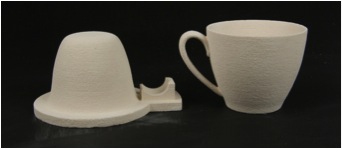University of West England Fires Up a Ceramic 3D Printer

To prevent an object from sagging during printing, researchers created a setting of the object prior to beginning the printing process. Above you can see a 3D printed ceramic cup with its support setting. Courtesy of UWE.
Latest News
March 28, 2014
By this point, we expect additive manufacturing (AM) advances in areas such as aerospace and the medical field, but the technology is so flexible, it turns up in many other industries as well. Hollywood is using AM to build props and costumes for the movies, musicians have benefited, as have athletes. Slowly but surely, AM is working its way into nearly every field where with a need to build complex designs or for rapid manufacturing.
Researchers at the University of West England (UWE) Bristol have developed yet another use for AM, this time for creating ceramics. UWE’s ceramic 3D printing research first caught Rapid Ready’s attention in 2012 when the team discovered new uses for the ancient Egyptian ceramic called faience. Since that time, the team has perfected its ceramic printing process.

Printing in ceramics works in basically the same manner as other types of AM. A 3D design is created in CAD and is sliced up by the program before sending the information to a 3D printer. There, ceramic objects are built up in layers until you have a finished object. In the case of ceramic printing, the material used is called ViriClay.
ViriClay can be used to build cups, plates, saucers and so on for both the whiteware and tableware industry. While other ceramic AM systems do exist, researchers claim using their material will reduce energy consumption by 30% and produce objects of a high enough quality to be sold as end-use products. As is the case with most AM, the system requires days to produce a full set of anything, making it most useful for prototyping and specialty designs.
“The ceramic material developed at CFPR for use in 3D printing is both aesthetically pleasing and also a functional material, unlike the typical prototyping materials commonly used in 3D printers,” said Stephen Hoskins, research team lead. “The ceramic material can produce items of a high quality both in terms of design and also in terms of function—it can create elegant tableware and ornamental ceramics. Because of its aesthetic qualities, it appeals to designers and artists who want to create lasting products that are also beautiful.”
Plans are in place to give artists a chance to work with the new material and printing process through interaction with a new company named Argillasys (from the Latin word for potters clay). The company will act as a service bureau for designers to manufacture 3D printed ceramics, including an online store where specialty items can be sold.
Below you’ll find a video about ceramic printing.
Subscribe to our FREE magazine, FREE email newsletters or both!
Latest News
About the Author
John NewmanJohn Newman is a Digital Engineering contributor who focuses on 3D printing. Contact him via [email protected] and read his posts on Rapid Ready Technology.
Follow DE





